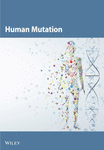X-linked spondyloepiphyseal dysplasia tarda: Novel and recurrent mutations in 13 European families†
Communicated by David Rimoin
Online Citation: Human Mutation, Mutation in Brief #725 (2004) Online http://www3.interscience.wiley.com/homepages/38515/pdf/mutation/725.pdf
Abstract
X-linked spondyloepiphyseal dysplasia tarda is a skeletal dysplasia mainly affecting the vertebrae and epiphyses and commonly associated with the early development of degenerative joint disease. Radiographically the disorder is characterized by a typical hump-shaped deformity of the vertebral bodies. SEDT is caused by mutations in SEDL located on Xp22.12-p22.31. To further elucidate the spectrum of underlying variations we performed a screening of all 6 exons of SEDL within 13 European SEDT families and identified 6 new (c.99delC, c.183_184delGA, c.236-5_236-8delATTA, c.325delT, c.345_346delTG, c.94-?_423+?del) and 9 previously reported mutations (c.1-?_93+?del, c.93+5G>A, c.157_158delAT, c.210G>A, c.236-9_236-12delTTAA, c.267_275delAAGAC, c.324-4_324-10delTCTTTCCinsAA). The recurrent splice site alteration c.93+5G>A (formerly described as IVS3+5G>A) was detected in 3 unrelated families. Two patients were carrying 2 changes in the allele. In one case, a novel variation in exon 4 (c.99delC) was associated with several nucleotide deletions in intron 4 (c.236-5_236-8delATTA), and in the second case we identified a previously reported transition c.210G>A and a novel deletion in exon 6 (c.325delT). All sequence variations identified are either deletions of complete exons or predicted to result in a premature stop codon or to lead into splicing defects and are associated with a loss of considerable parts of the sedlin protein. © 2004 Wiley-Liss, Inc.




